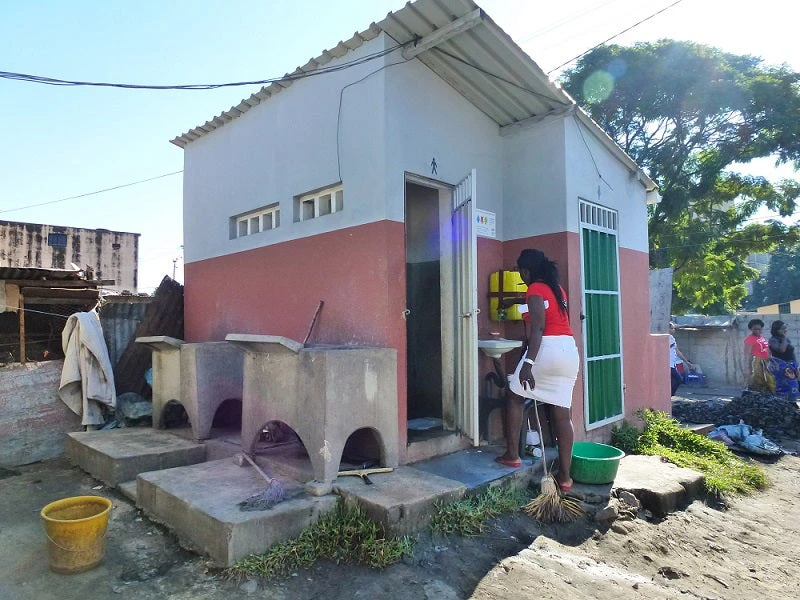
Poor sanitation is the all too familiar story in many expanding African cities and Mozambique’s capital city Maputo is no exception. In fact, over half of the country’s urban population lack access to even basic sanitation. With an estimated 668 million city dwellers around the world not having access to safe sanitation, overcoming sanitation challenges in cities like Maputo will go a long way towards achieving the Sustainable Development Goal for safe sanitation (SDG 6.2).
But large numbers can sometimes obscure or make abstract the tough reality for individuals and families. The experience of Rute Rodrigues, a widow and mother of five children living in one of many densely populated low-income neighbourhoods (known locally as ‘bairros’)’ is a common one. As she recounts: “We had a precarious latrine that over the course of time became damaged and collapsed due to heavy rains leaving us without access to even basic sanitation”.
The Maputo Municipal Council has been grappling with this problem for the thousands of people like Rodrigues living in the densely populated bairros. While individual household toilets should always be the ideal, shared sanitation can be an effective solution – and in some cases the only solution – in densely populated low-income areas , where lack of space precludes individual household toilets. However, the risks of these being badly managed and unhygienic are all too real.
Therein lay the challenge for the Maputo Peri-urban Sanitation Project (MPSP) funded by the World Bank-managed Japanese Social Development Fund (JSDF) covering the Nhlamankulu District and its eleven bairros, which had shared sanitation – including shared household and communal facilities – at its core. The program, implemented by Water and Sanitation for the Urban Poor (WSUP) and the Water and Sanitation Program (WSP) of the World Bank, drew on lessons learnt from many sanitation programmes in Africa and Asia demonstrating the need for inclusion, stakeholder ownership and sustainable management. This resonates with the current shift towards Citywide Inclusive Sanitation, with a focus on ensuring sustained service delivery rather than solely building infrastructure.
With less than one in ten households connected to a sewerage system and a lack of hygienic waste disposal and treatment facilities for the remaining population, Maputo reflects the reality in many cities across Africa and Asia. Improving access to safe sanitation meant including fecal sludge management and hygienic sanitation behaviour components in the MPSP. These were important for embedding the shared sanitation facilities in the community and for enhancing their sustainability.
The success, in terms of project outcomes, is largely due to the project’s emphasis on promoting stakeholder participation and ownership at all levels, from location selection to community-led management of the shared sanitation facilities. The training of community leaders and local administration staff in the monitoring of water and sanitation services, awareness creation/sanitation promotion and in establishing user fee contribution for both capital and maintenance costs, were great sustainability enablers.
Enabling access to safe sanitation to 8,600 inhabitants, including Rute Rodriguez and her children, in eleven bairros, through 400 shared and communal facilities, is another important outcome. With the new toilets, the residents of Nhlamankulo felt a new sense of dignity, with improved privacy and safety for women, and improved access to sanitation for people with disabilities. Sustainability and sense of ownership were also strengthened by the participatory process and financial contributions by the households. Equally valuable have been the program lessons, which have influenced the Sanitation and Drainage Master Plan for Maputo (2016-2020) and helped to progress the introduction of a planned sanitation tariff.
As envisaged, the shared sanitation facilities have given more security and improved the well-being for women and children in these densely populated bairros. The active participation of women in the sanitation management committees (SMC) has been key. One of the women, Melita, , has lived in the Chamanculo C bairro since birth and has had to live with the problems caused by poor sanitation. When Melita and her neighbours applied for a new sanitation block, Melita decided to become the Vice-President of the SMC. Melita notes: “My role has always been to mobilize people to help solve our toilet problem and fortunately, perhaps because of the suffering we were experiencing, the people in this group contributed in good time and, much sooner than we imagined, we received the great ‘Blessing’ of our lives!”
The Maputo Municipal Council (MMC) is optimistic but recognises that there is a long road ahead to achieve universal sanitation coverage in the city. There are encouraging signs that the improvements in the enabling environment is helping to trigger more investment, including by the World Bank, bilateral donors and international NGOs.
Despite some doubt from stakeholders at the start of the program, as it draws to a close, they have renewed confidence that shared facilities can help the city of Maputo reach its goal of universal access. Not only has the program strengthened MMC’s commitment to shared sanitation but it has also built the council’s capacity to support sustainable citywide services in the future.
To learn more about Shared Sanitation, check out the World Bank’s recent publication:
Shared and Public Toilets: Championing Delivery Models That Work
This blog is part of a series on shared sanitation. To read about other experiences, check out:
An Introduction to Shared Sanitation: How many people can share a toilet?



Join the Conversation